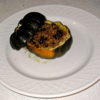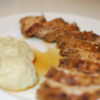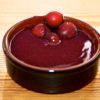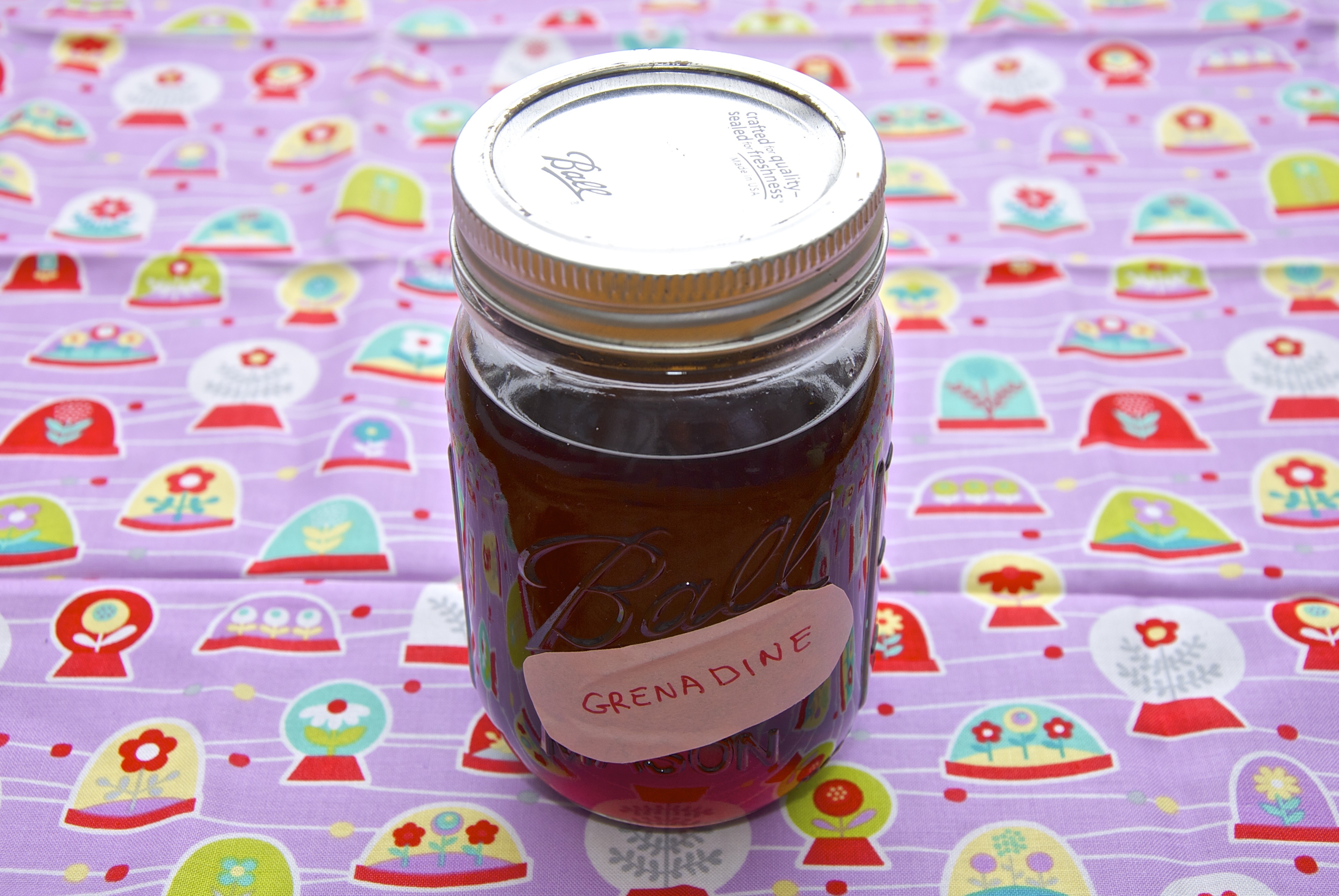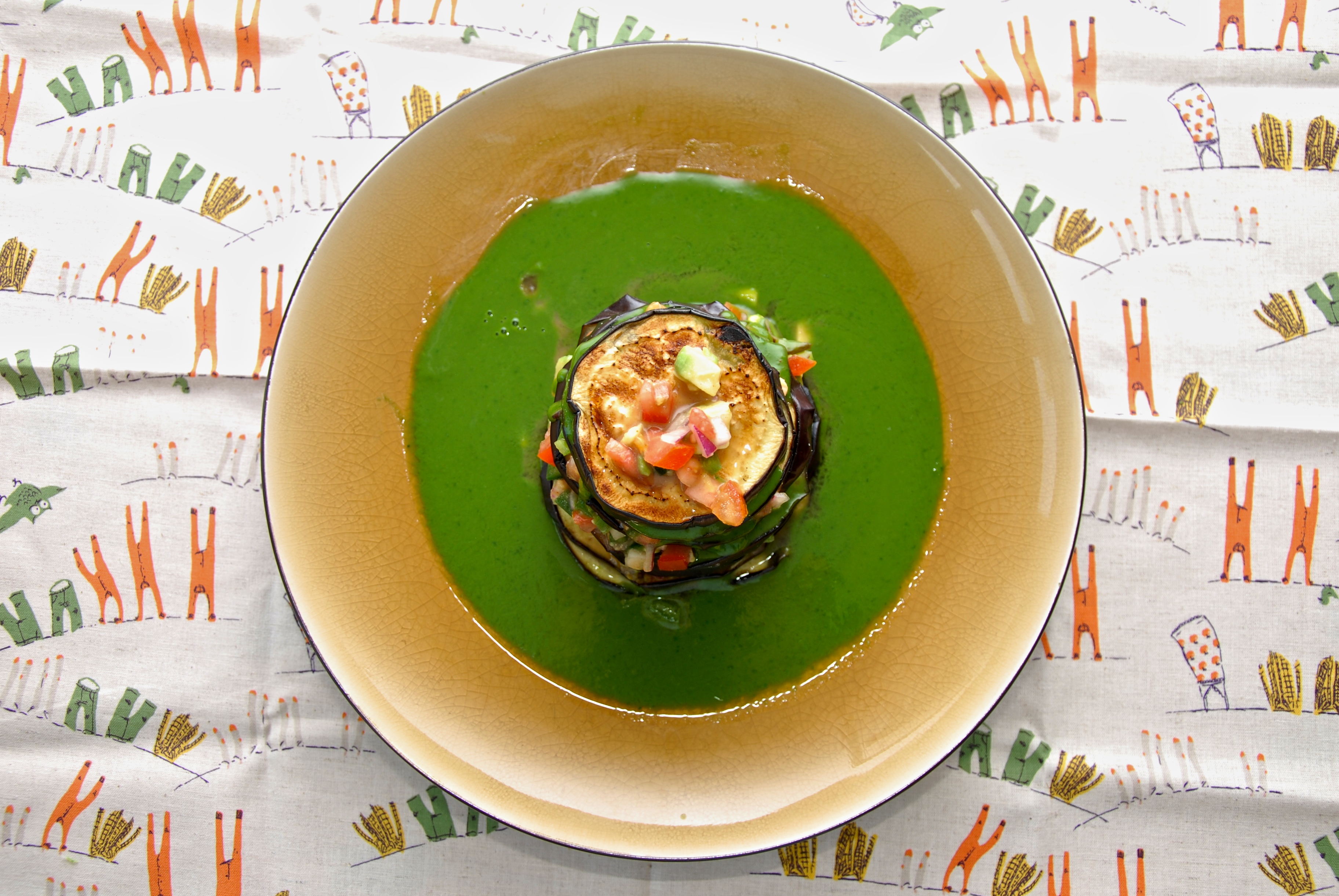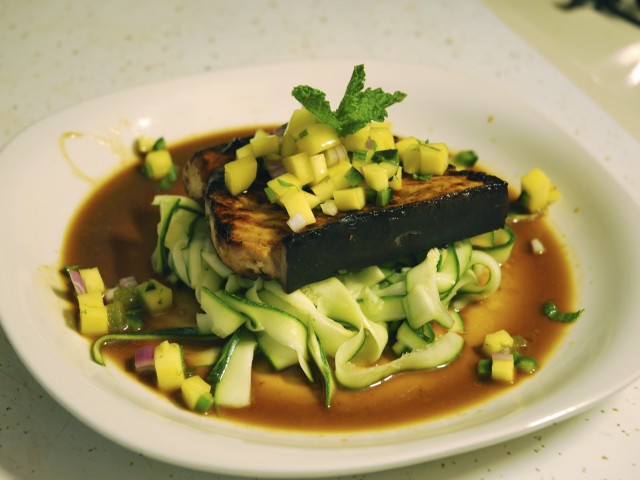
Usually around this time I start posting a series of post entitled Summer Food. But, what is summer food? What makes a great summer food plate? It has to be, simple, fresh, not heavy in oils and fats, and most importantly remind you of summer. Being in Boston the summer food time is a little late, but it is here at last, and being in Boston it is a great opportunity to get our hands on some fresh amazing fish. This time some freshly caught (or at least I want to believe freshly caught) swordfish. Served with an unusual type of pasta…
Swordfish is regarded as an oily fish although it is significantly less oily than salmon or smelt. The flesh of the swordfish is white lightly translucent turning opaque when cooked. There is also a variety that is called pumpkin swordfish that has an orange tint flesh, mainly due to their diet of shrimp or other prey. This unique taste and look makes then as premium seafood that usually ends up in high-end restaurants and is hard to come by. Swordfish due to its large size is a particularly popular fish for cooking with a variety of techniques. The muscle-skeletal structure results in a large muscle groups, small bones and very unique muscle constructions. The swordfish does not have the distinct flaky structure of other fishes have, resembling more tuna than salmon. This allows it to be cooked in a variety of techniques that are not used with other fishes like, steaks, chops, or skewers. Swordfish although flavorful and meaty it comes with a significant problem. As it is true for all large fishes that swim in the sea for many years they accumulate heavy metals like mercury. Although the levels are not very high large amounts can be potentially dangerous. The FDA recommends that young children, pregnant women, and women of child-bearing age not consume swordfish… But you know once in a while is not as bad.So for this recipe we will need:

- 2 1/2 lb Swordfish steaks
- A large zucchini
- 1 mango
- 1 jalapeno
- Mint (or cilantro)
- 2 limes
- 1 red onion
- 1/2 poblano pepper
- Cayenne pepper
- Olive oil
- Salt and pepper
- Optional… Tequilla
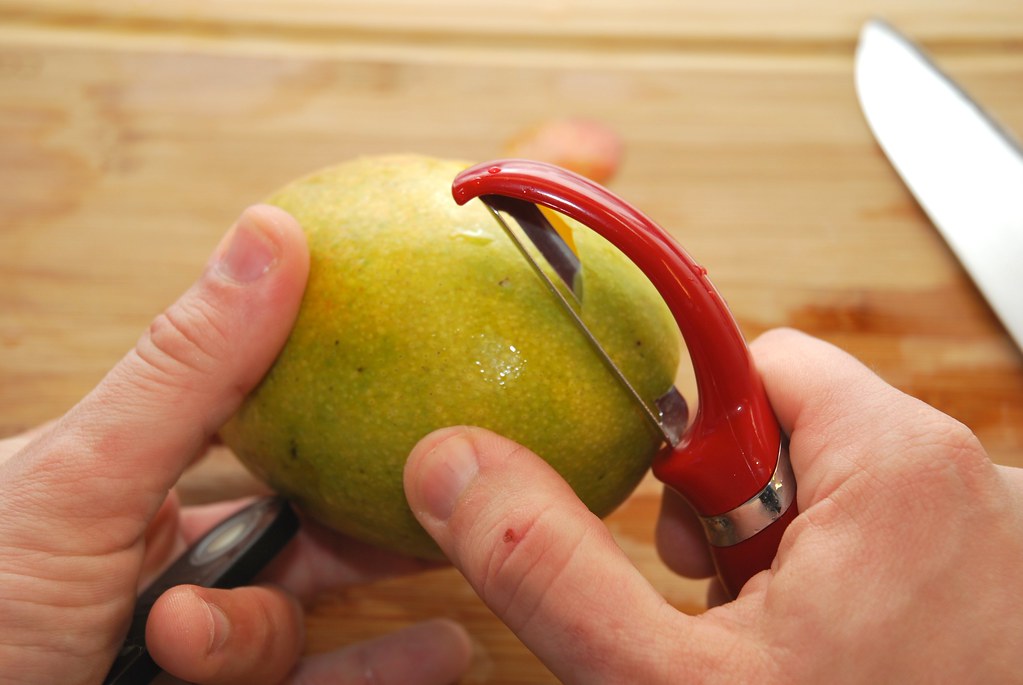
Start by peeling the mango. In the past I suggested the crisscross scoring and the inside out method for cutting it. Although a fancy method, it is not very clean and not useful. Pealing and cutting is faster, cleaner, neater.
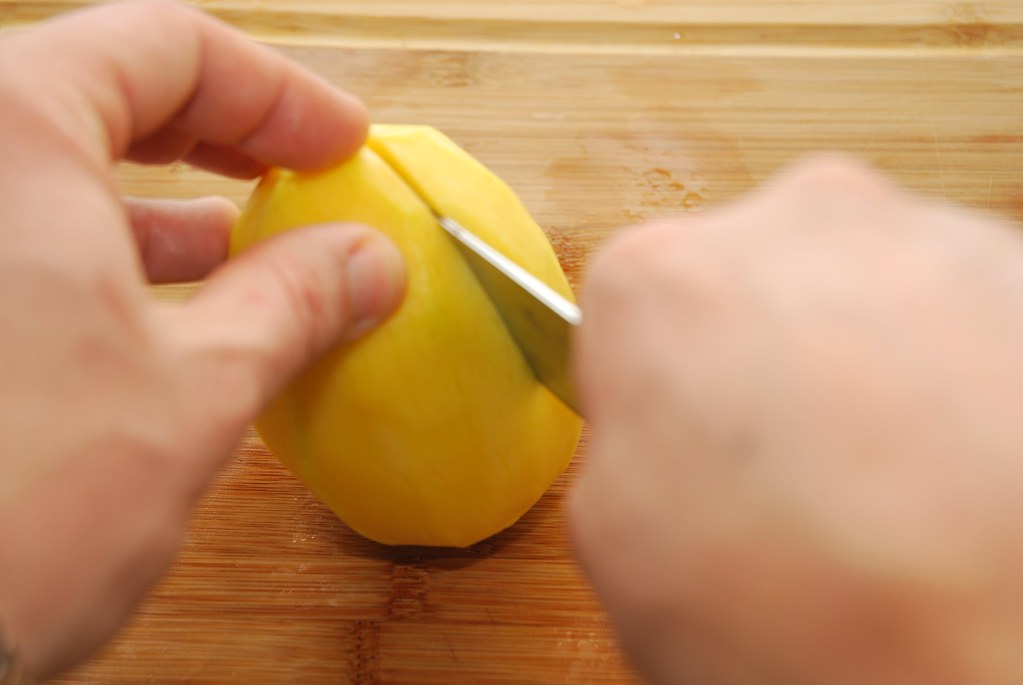
Cut the sides of.
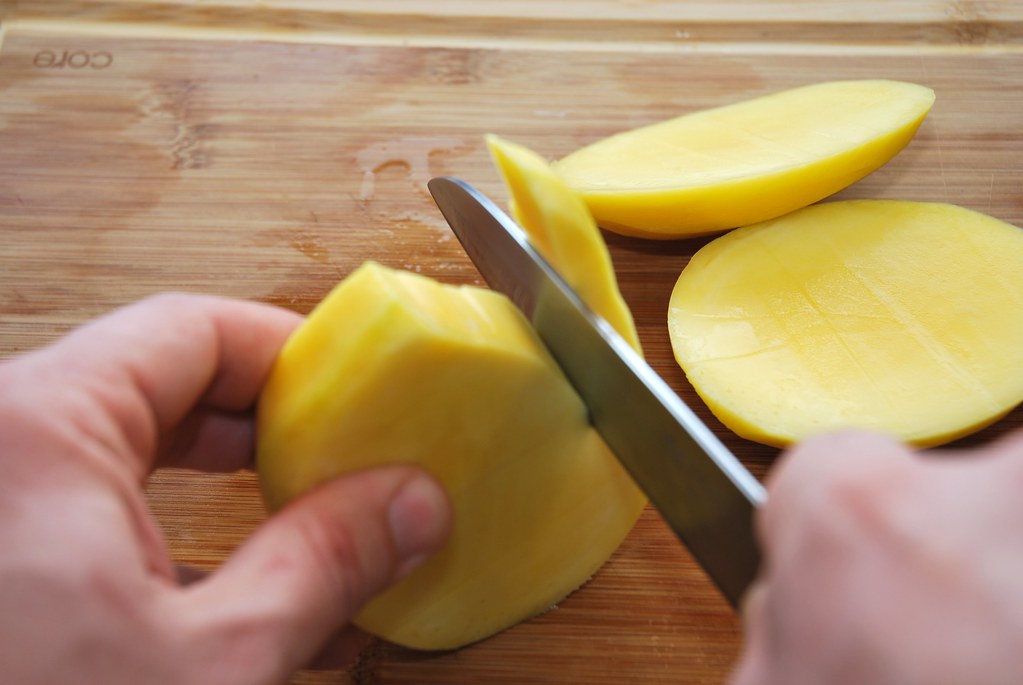
And scrape the remaining flesh around the seed.
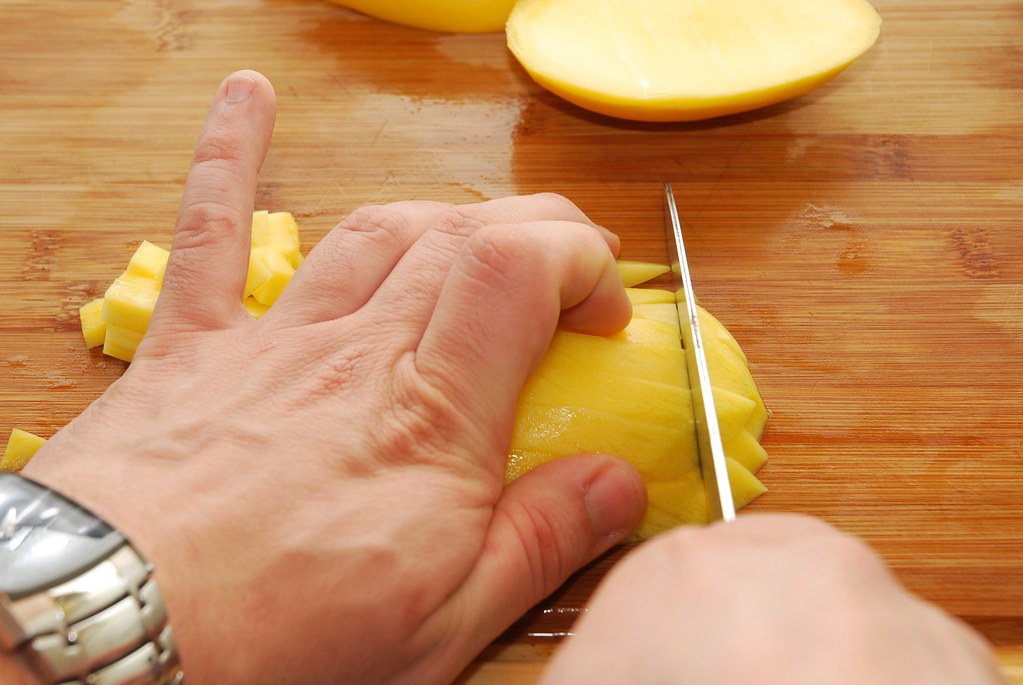
Dice it in small pieces. Yes, I know pinky flies away again… Oh well…
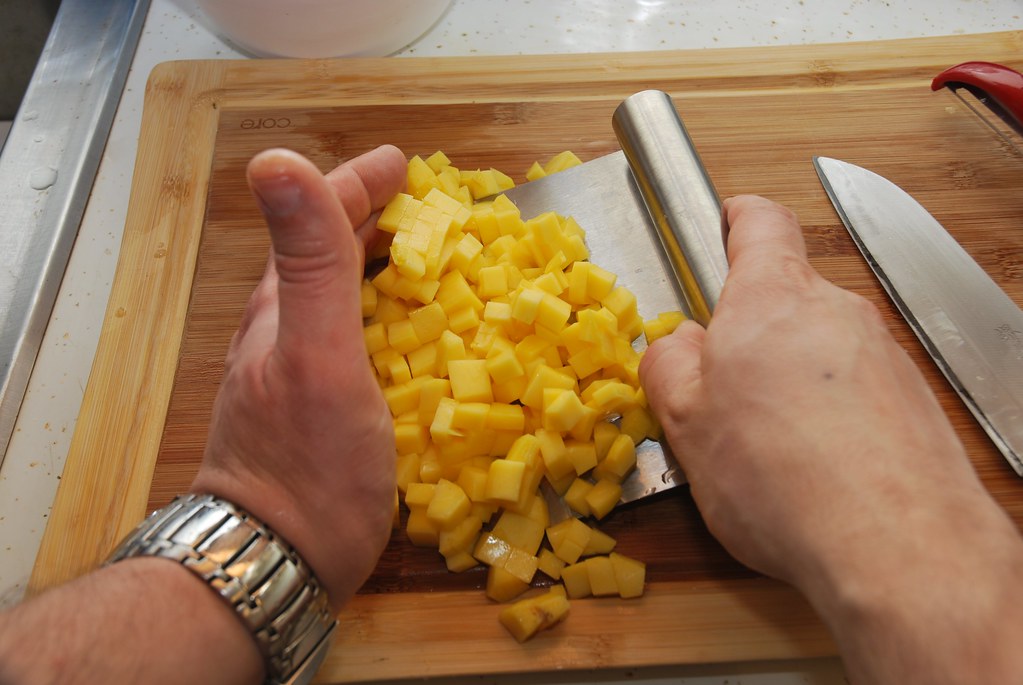
Using a scraping tool scoop it into a bowl.
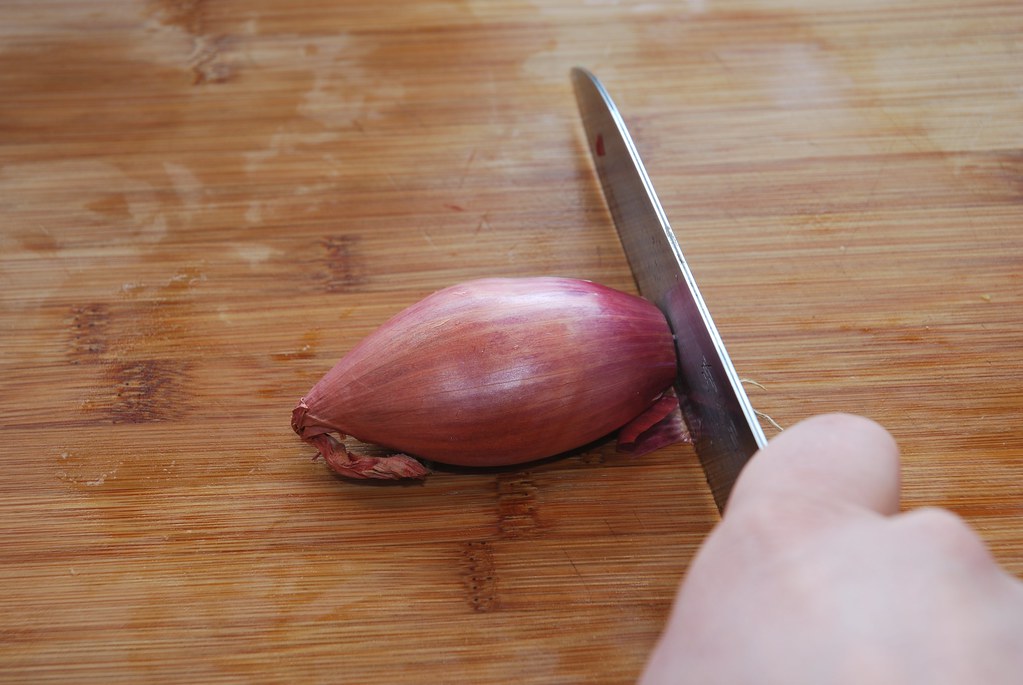
Take the onion… (I know it is not an onion it is a shallot, but the onion in the ingredients image was not good, and all I had was a shallot. Let’s pretend you did not see this and continue)

Cut it horizontally and vertically…
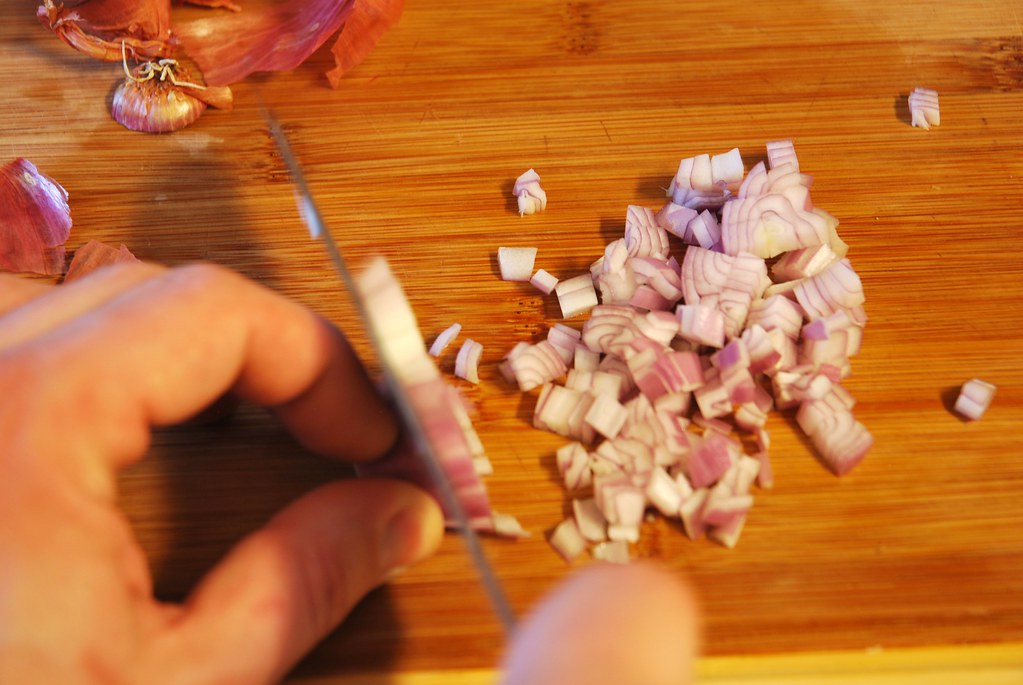
…and dice it. Off to the bowl it goes.
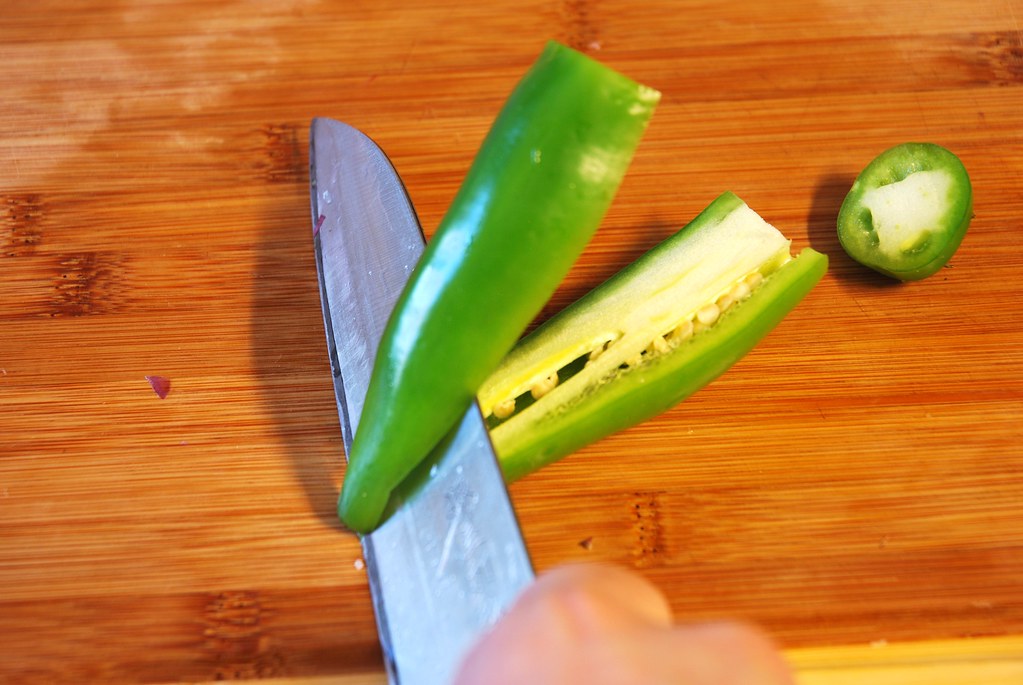
Cut the jalapeno lengthwise. Be moderate and in control of the heat. use as much as you need. Not too spicy… (hahaha right!)

Half we will blacken in direct fire.

The other half will be seeded
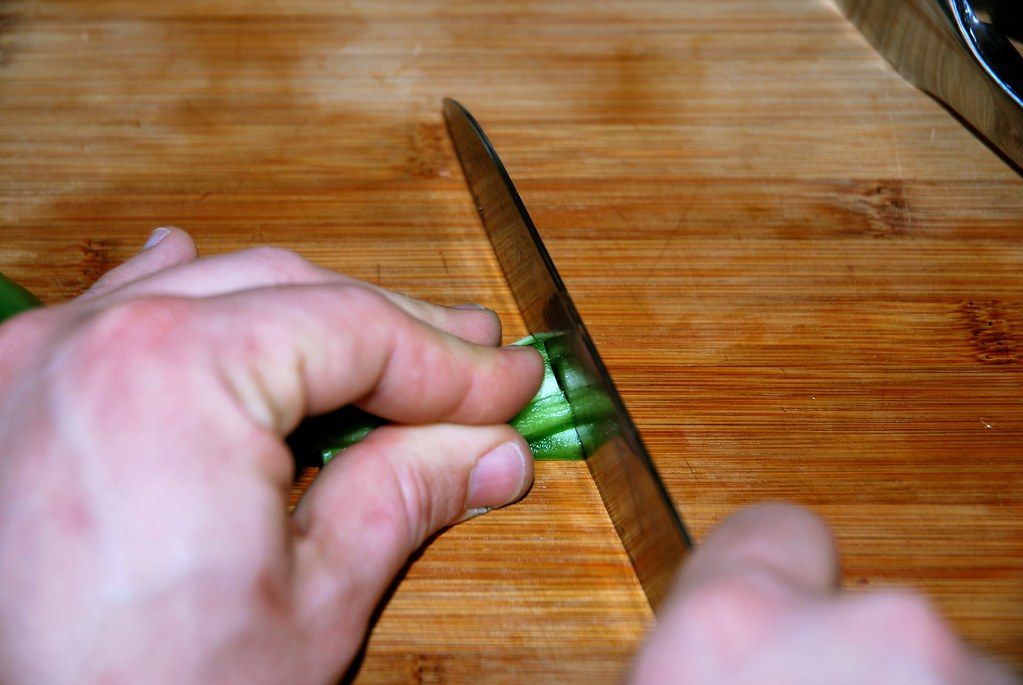
and diced.
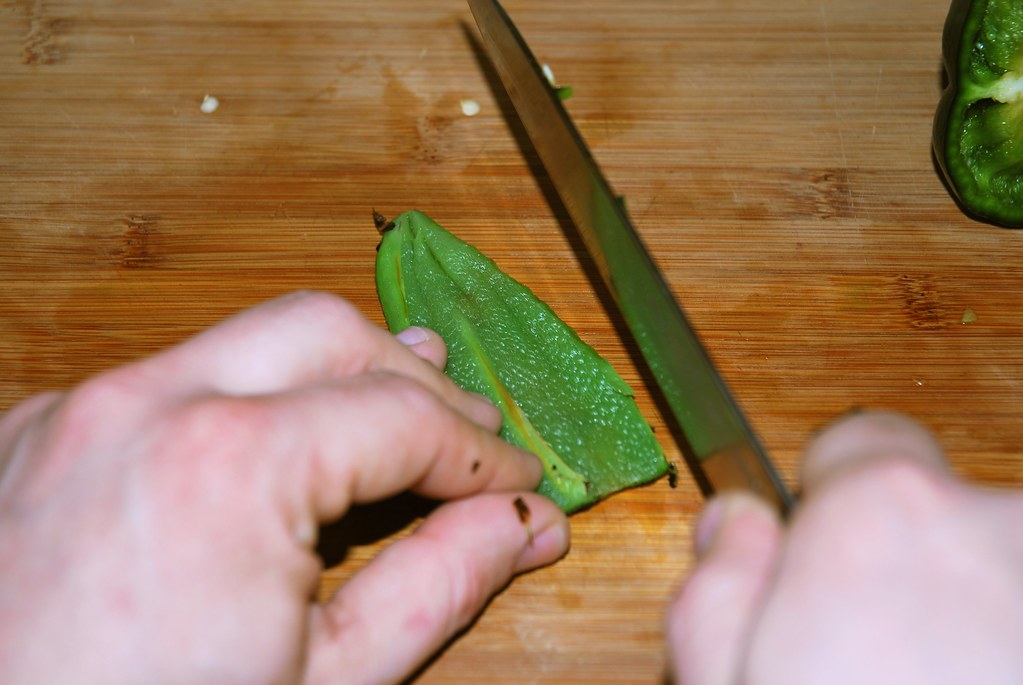
Same for the charred half.
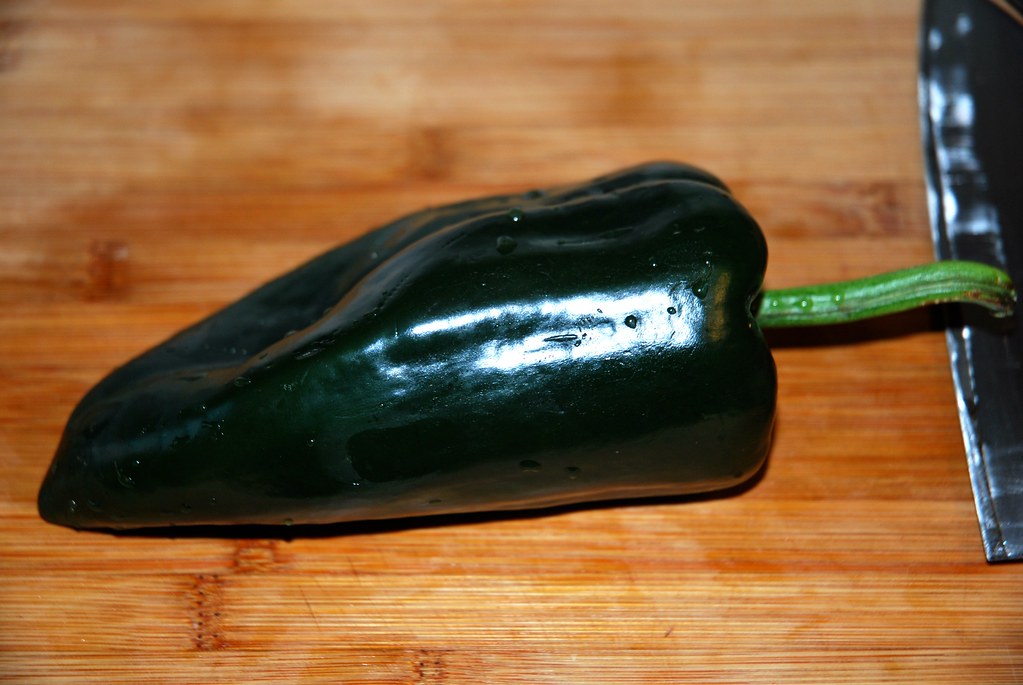
Now cut the poblano in half lengthwise.
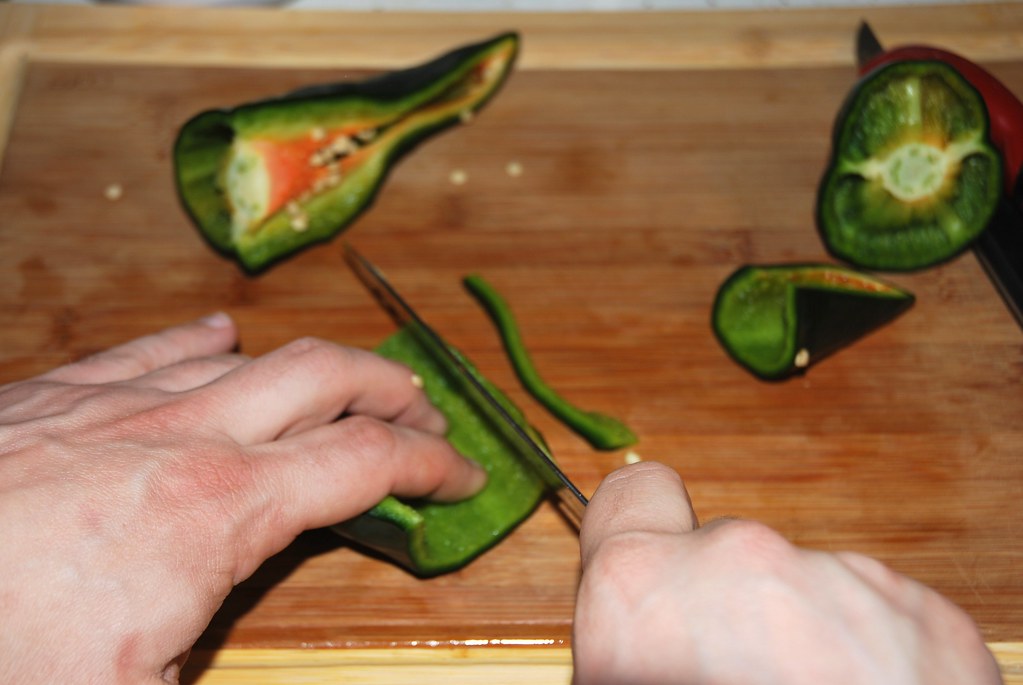
Julienne the pepper (that is fancy talking for cutting into sticks).
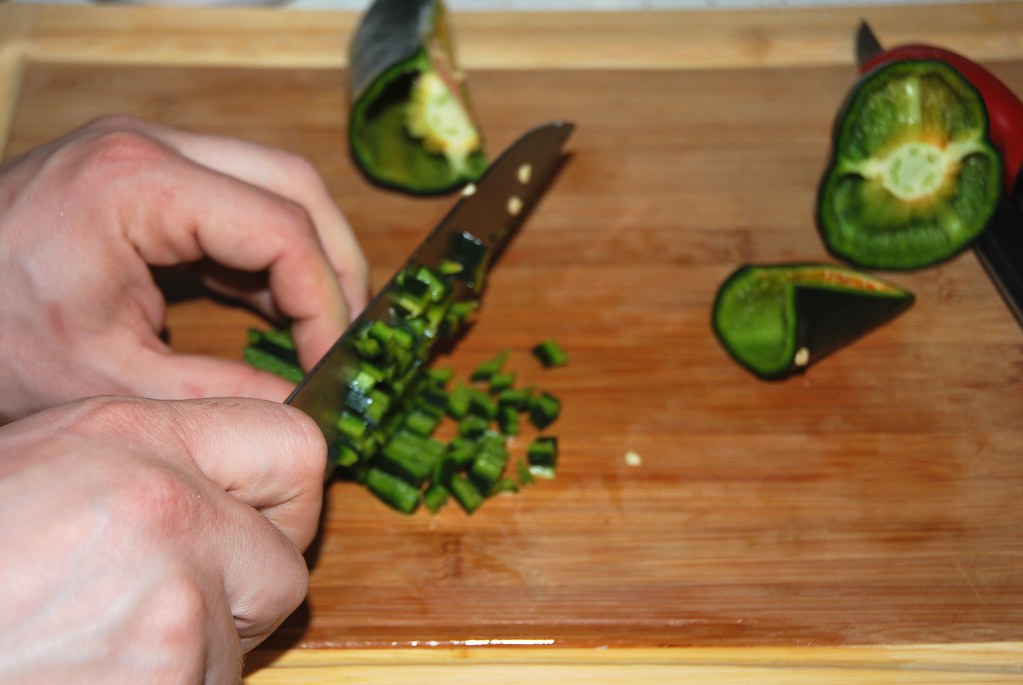
And dice… Note to self: Focus on the food not the hands. Of to the blow it goes.
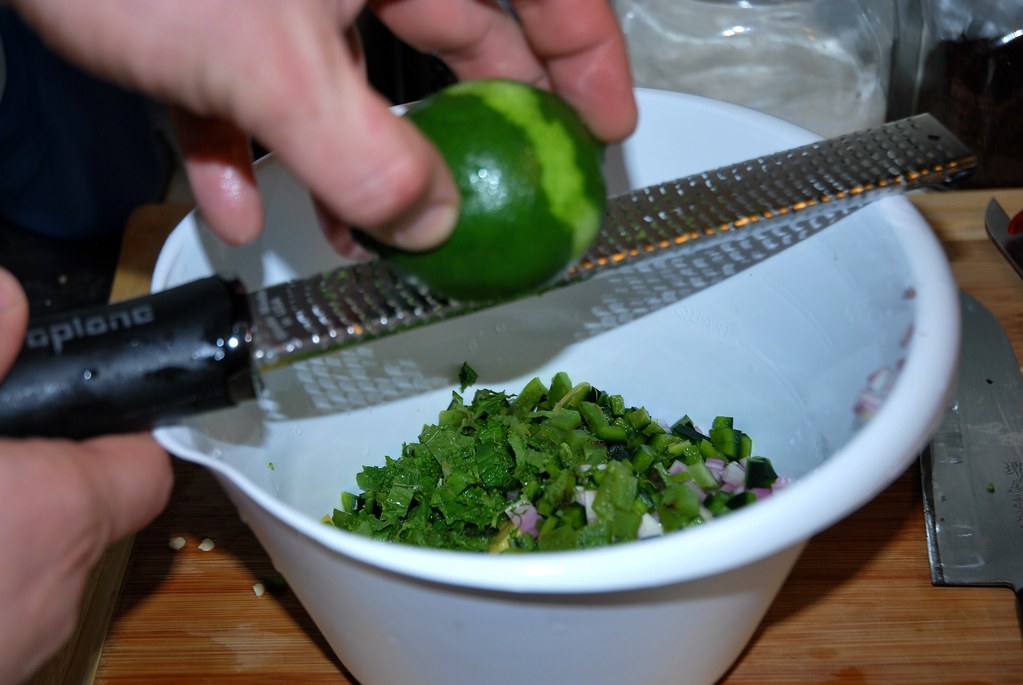
In the bowl add some lime zest and the finely chopped mint.

And the juice of the related lime.
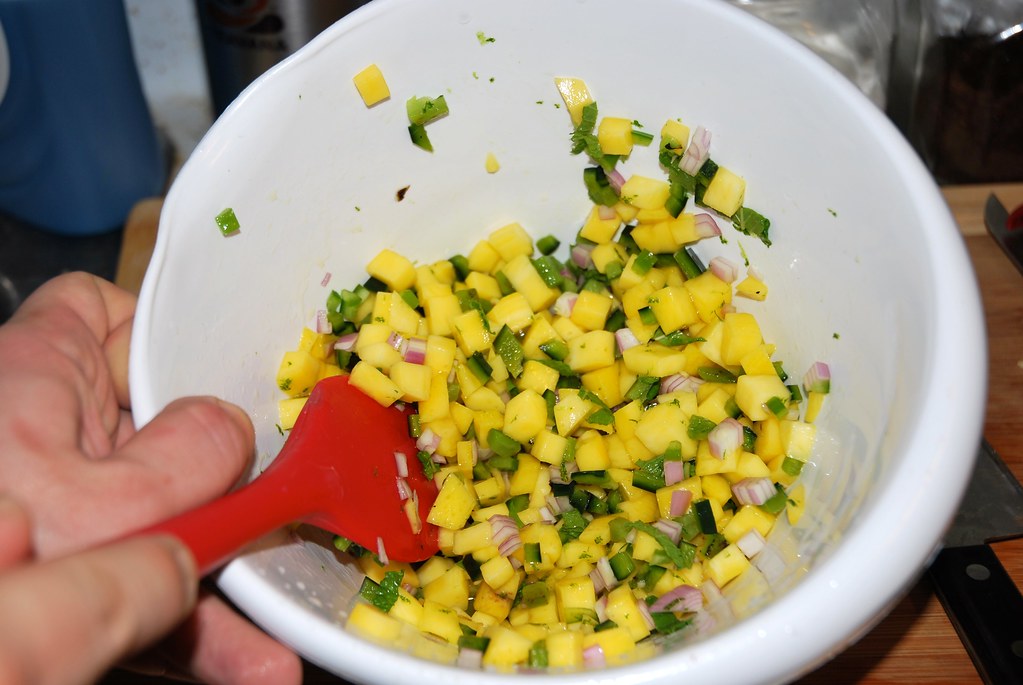
Mix well.

Season with some salt, pepper, cayenne. In this case I only added salt. It was spicy enough from the jalapeno. Transfer the salsa to another bowl and keep about 1 cup.
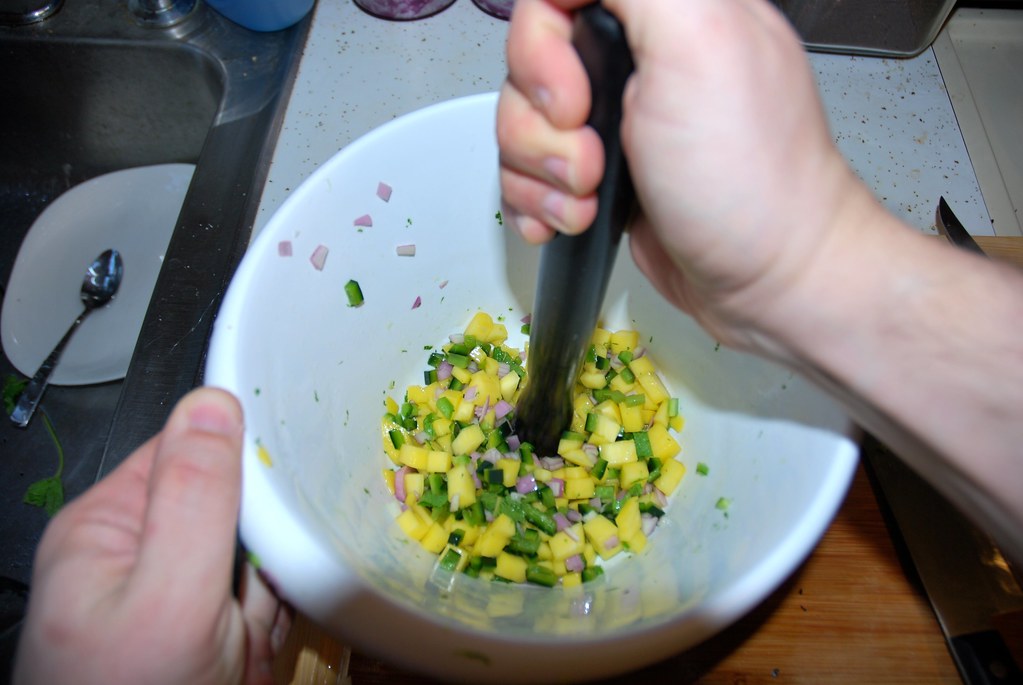
With a blender, or lot’s of manual labor, turn the salsa into a mush.
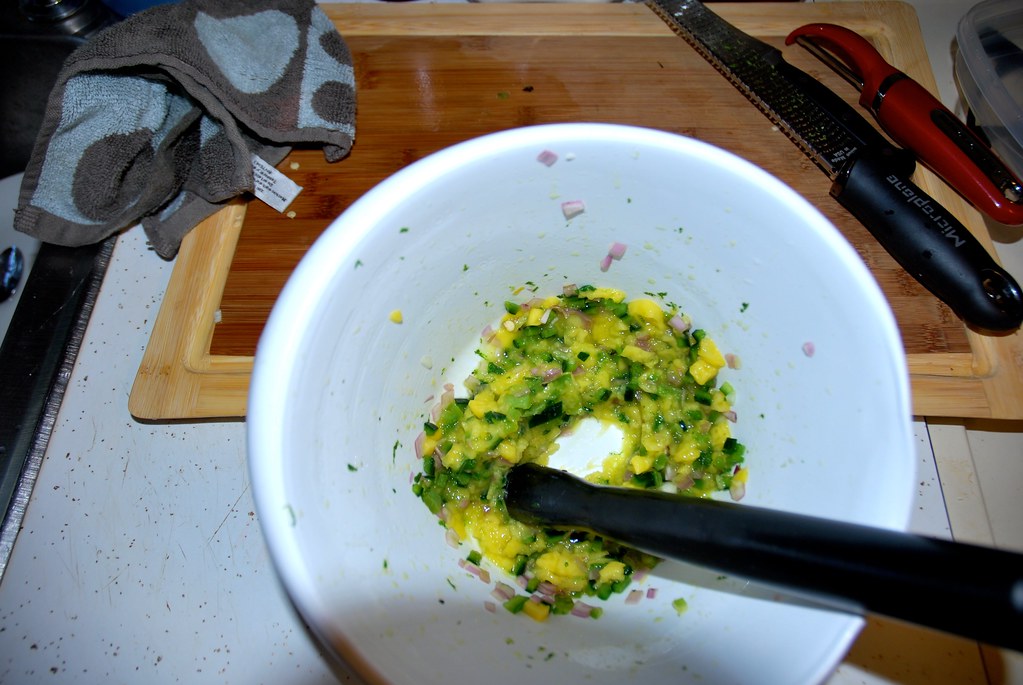
A mush like this. This will be part of the marinate… Actually it IS the marinate.
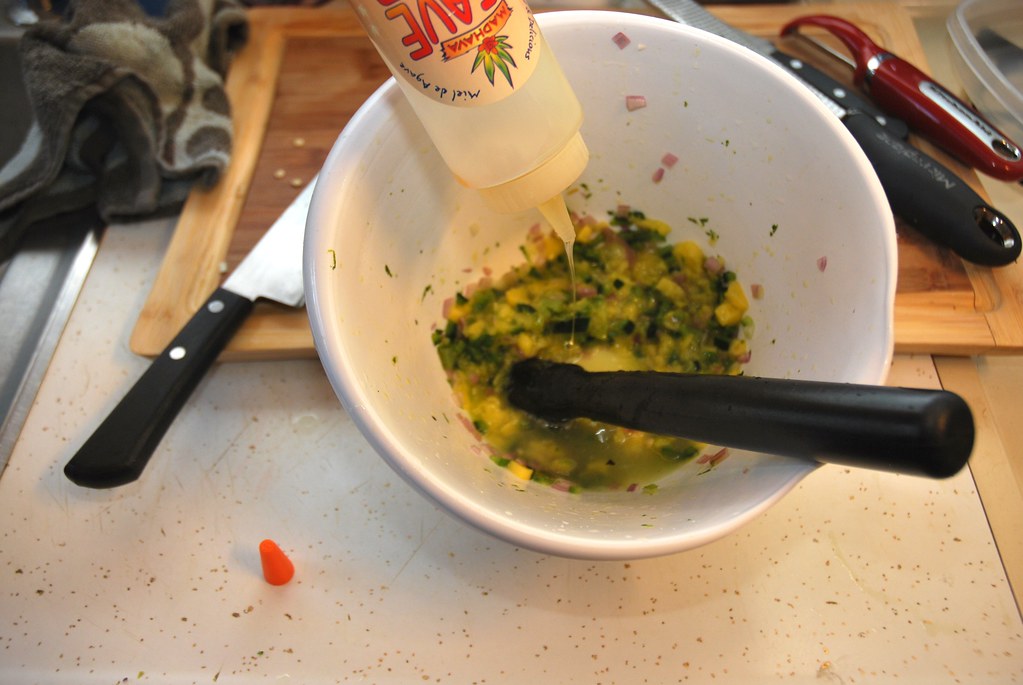
If the many is not very sweet add some sweetness, like Demerara sugar, or even better agave syrup. The sugars will caramelize and give an amazing flavor.
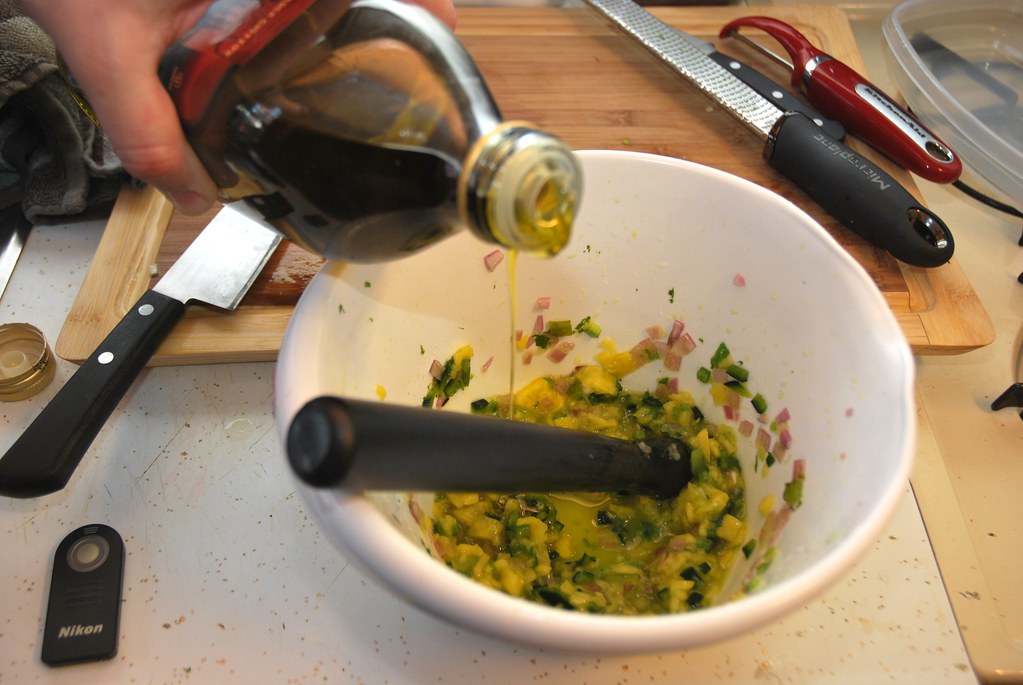
Follow that with some oil.

Dilute it with some water. Now save 1/2 cup of this mixture… Why? You will see…
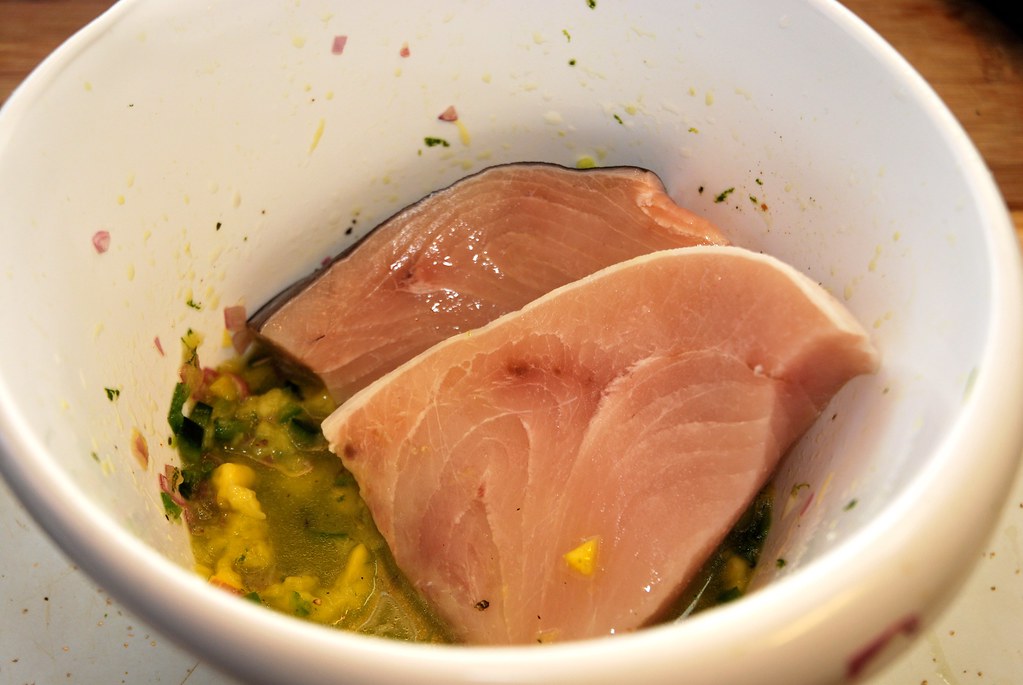
Add the steaks.

And toss the around to cover them well. Let them marinate for a 30 mins to an hour. The marinate is too acidic and long marination will just make the fish very firm.
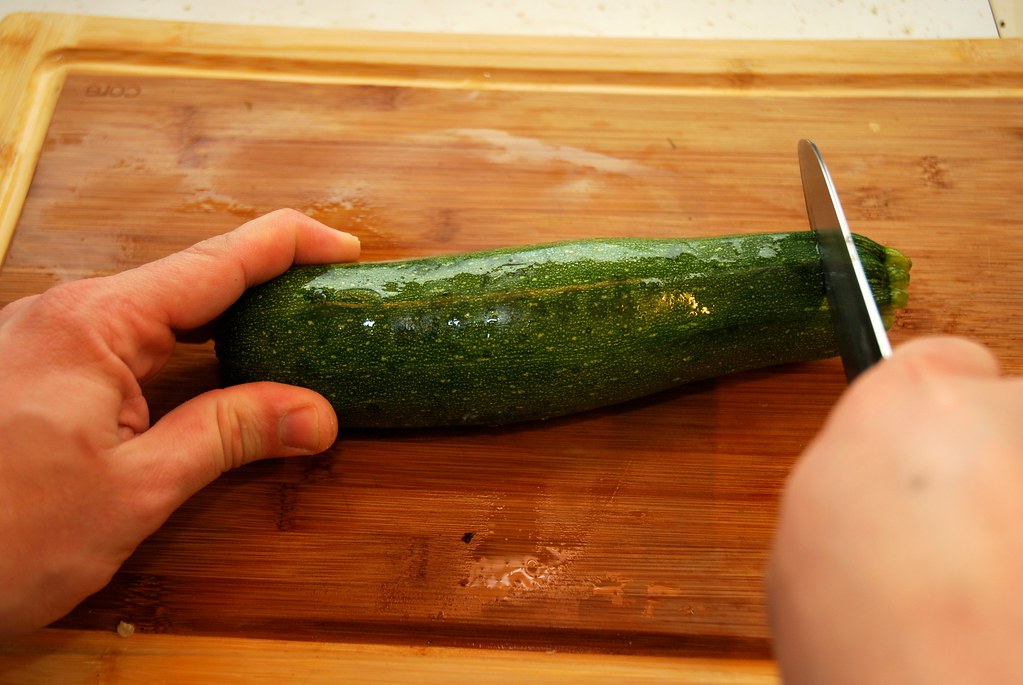
The meantime we will be busy with the pasta… or whatever you call it. Cut off the ends of the zucchini.
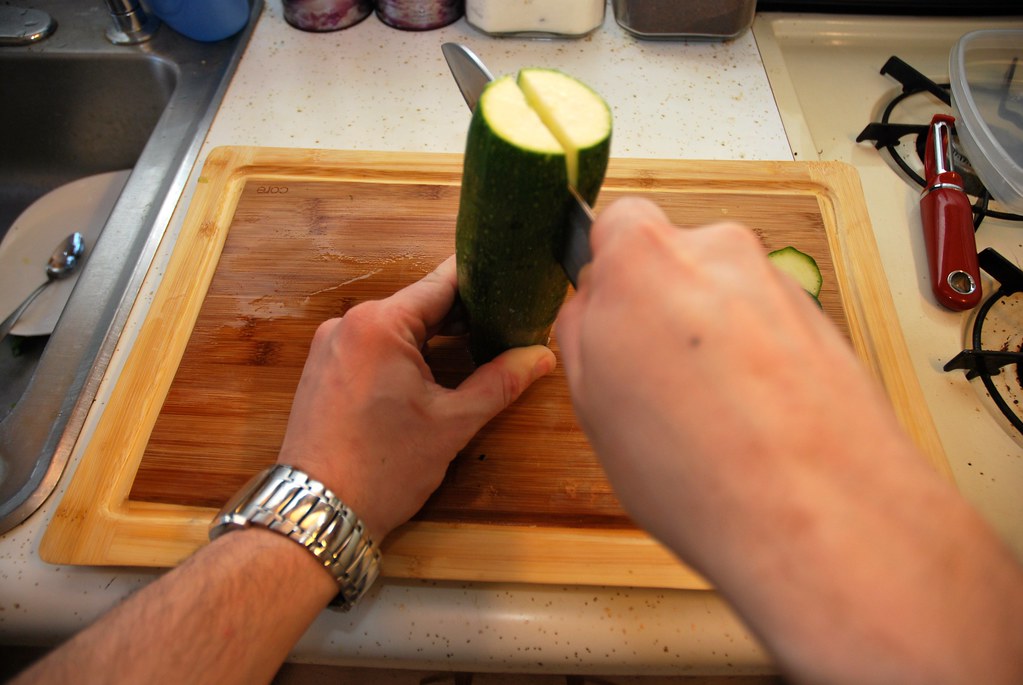
Cut it lengthwise.
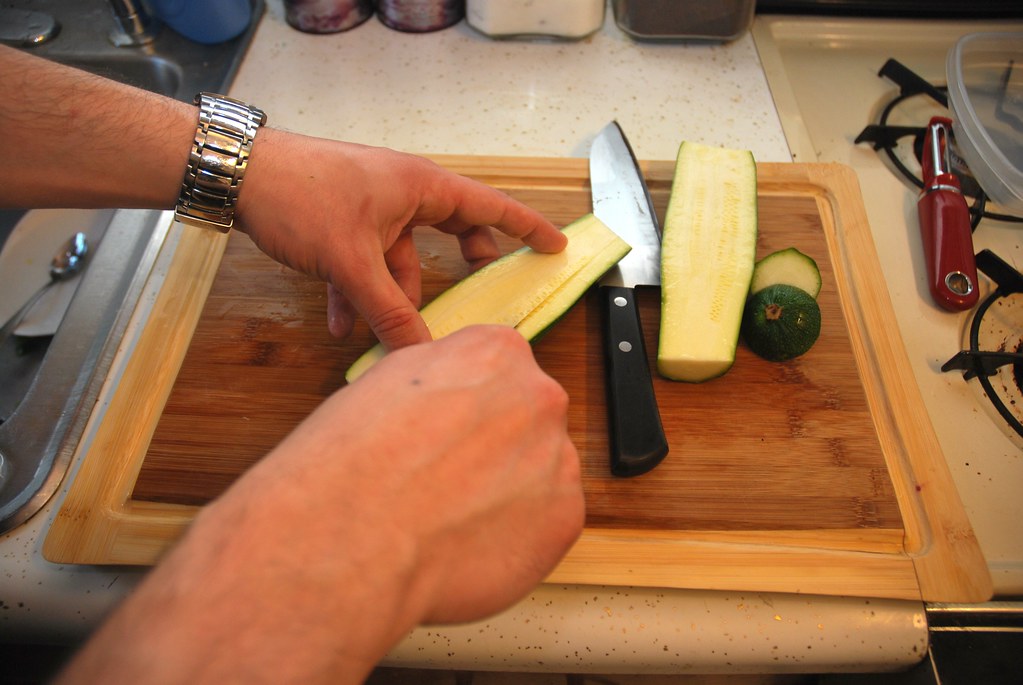
Seed it.
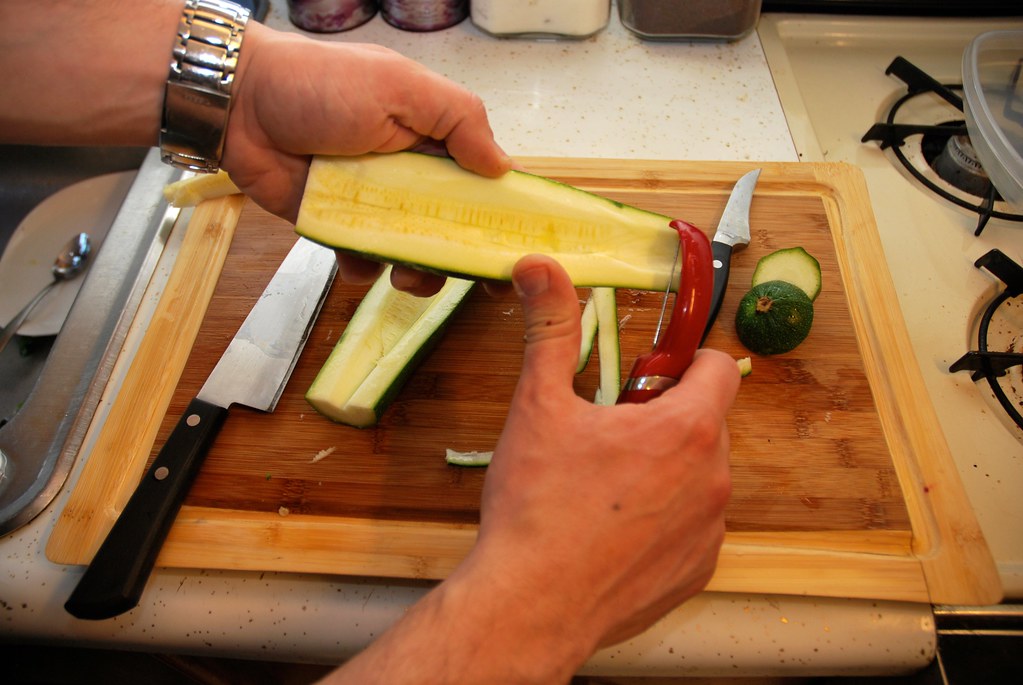
With a vegetable peeler cut thin strips of the zucchini. This resembles closely linguine.
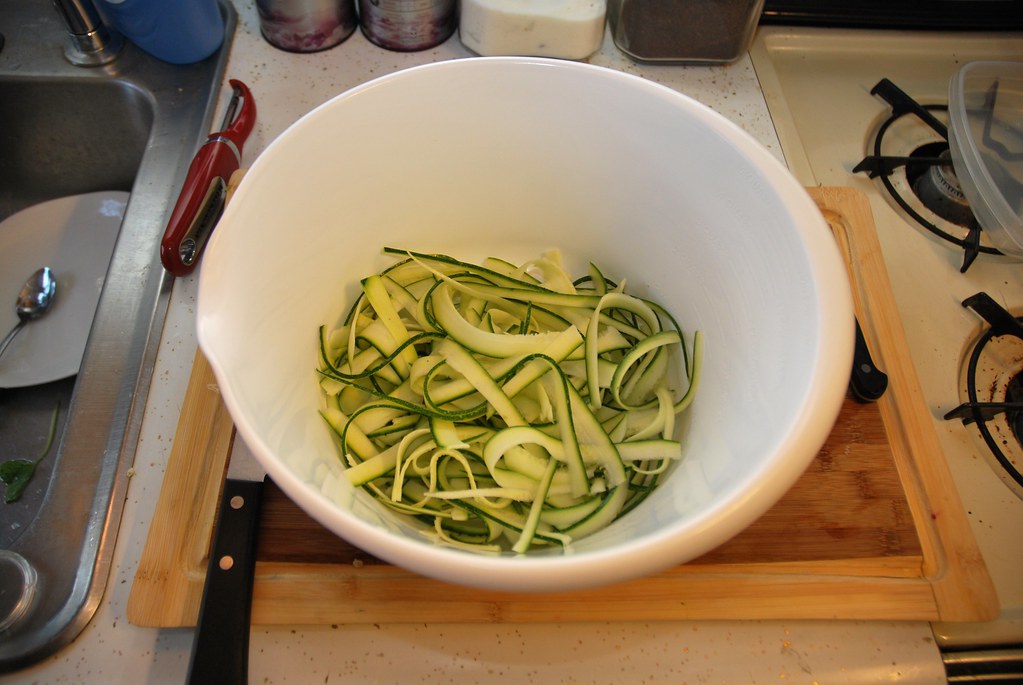
It is a laboring process with no shortcut, but it worths the effort. The resulting zucchini has a very distinct texture.

Add some salt. The salt not only will season the zucchini, but will also pull out some moisture, collapsing the cell walls structures, making the zucchini more like a flexible al-dente pasta than a raw vegetable.

Ten minutes in the refrigerator and you can see how much the zucchini collapsed and reduced in volume almost thy half.
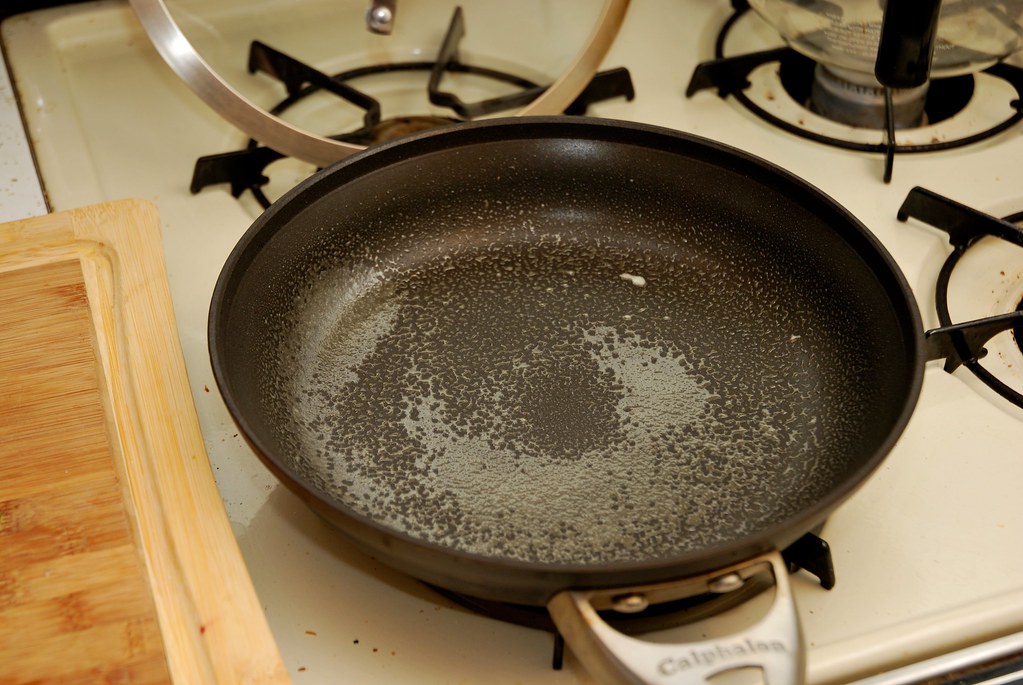
Now we cook the swordfish. Oil the pan well and let it heat up. We need a very hot pan to sear the swordfish well.

Add the swordfish and let it sizzle. Cook for 3 mins.

Flip one.
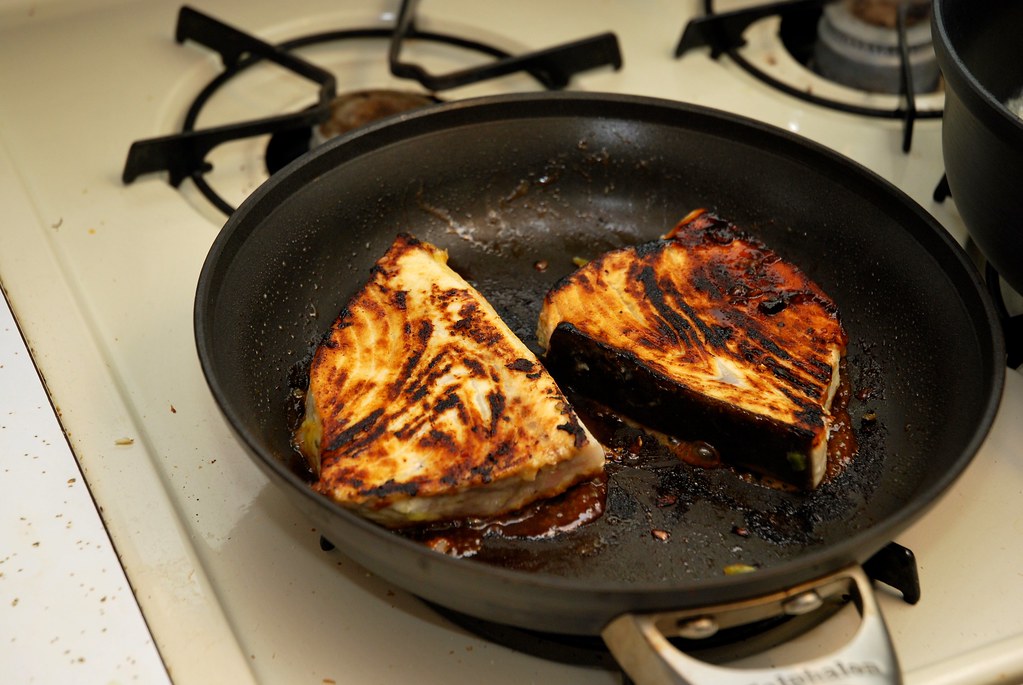
Flip two. I know that is the dark mahogany color of caramel. Burned? No it is not burned. It is just the sugars from the agave and the mango that are caramelizing.
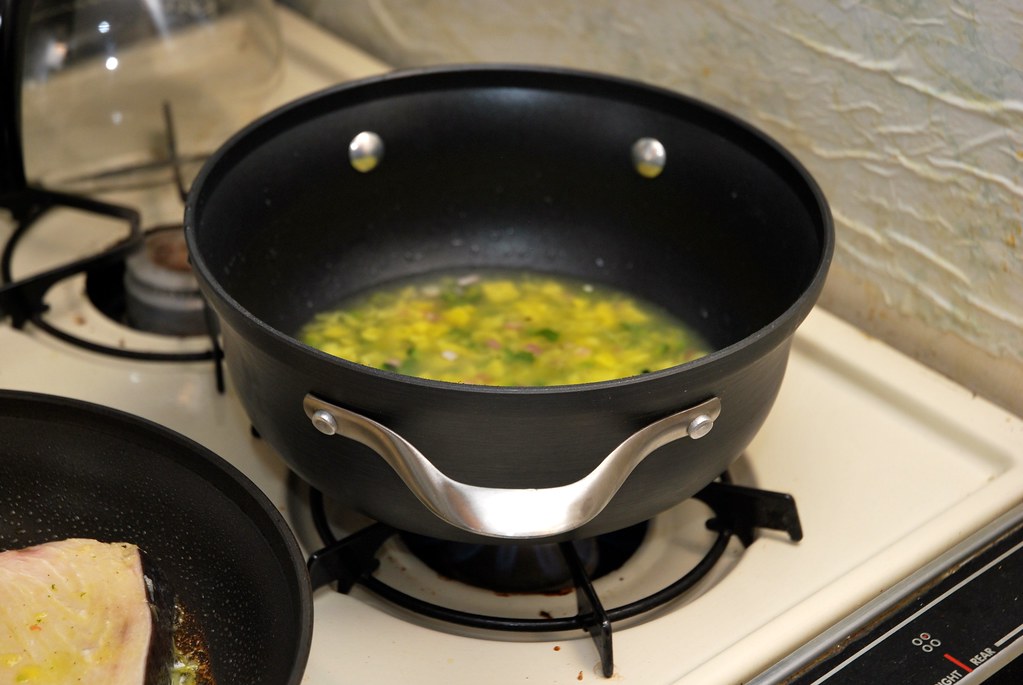
While this is happening. Bring the reserved 1/2 cup marinate with the 1/2 of water to a boil. I know… the recipe is getting complicated, but we need a sort of sauce to season that zucchini.
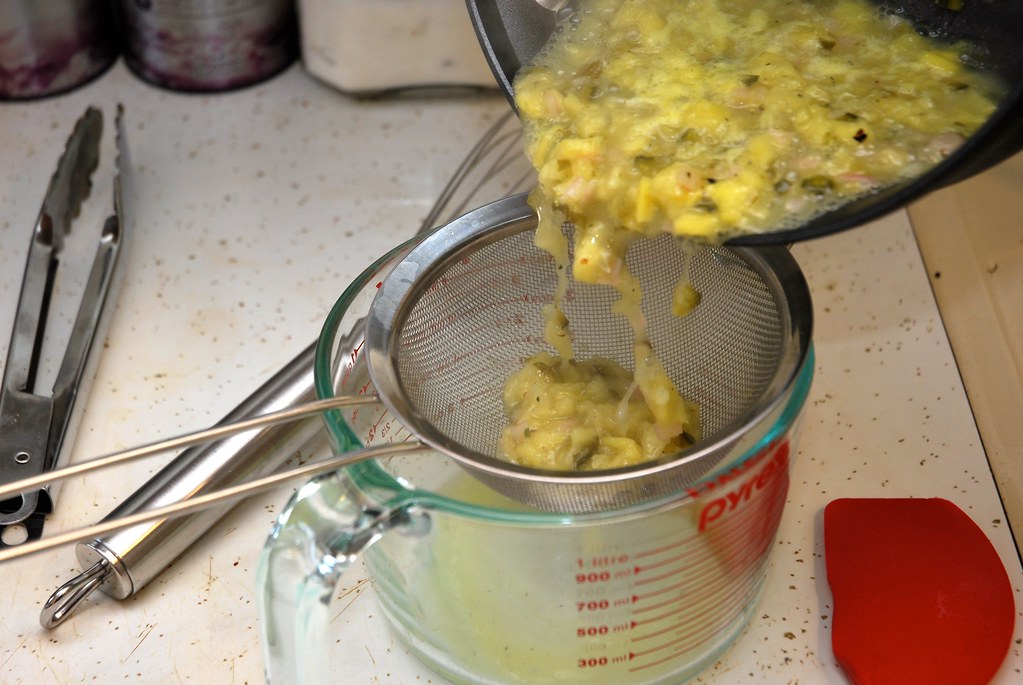
Once the fruits and the veggies are falling apart (3 mins after heating rolling boil), strain them.

Press them to get all the goodness out.
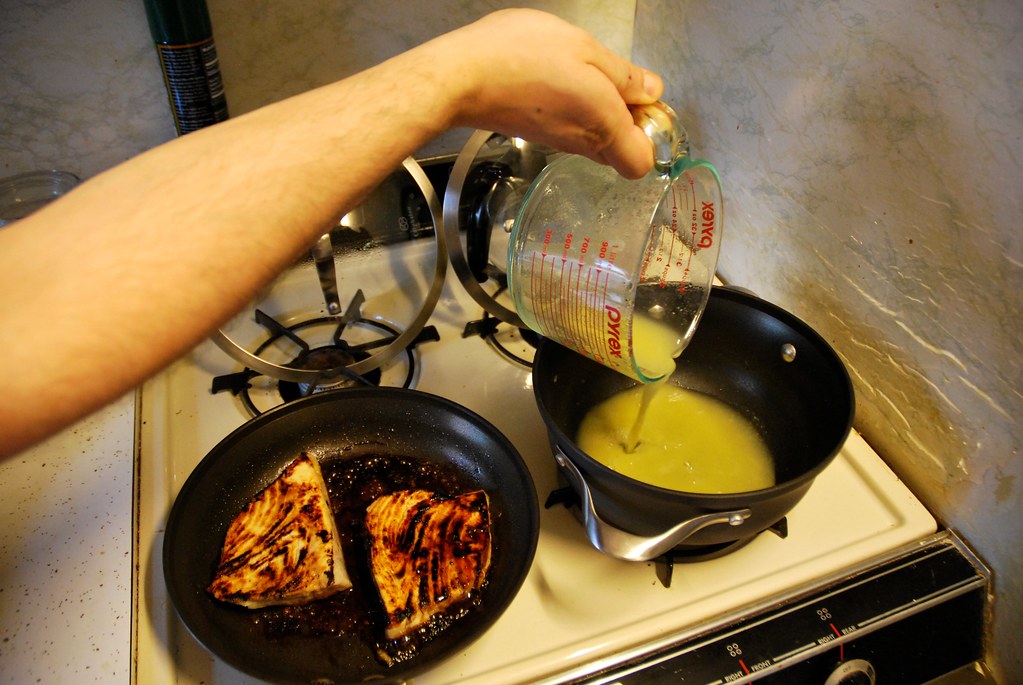
And return the reserved liquid to the pot to reduce it down to a syrupy consistency. Testimony to my commitment for excellence in this effort: look at the bizarre angle my arm has to go through in order to be able to shoot the action.Now the following steps are very, very important. We will deglaze and flambé the pan that the swordfish was in. Here are the 10 simple steps that you need to follow for a successful and painless flambé.
- Clear your airspace. No towels, hands, faces or eyebrows over the pan.
- Make sure you have lid, larger than the pot, to cover the pan if things go wrong and a pair of tongs to handle it with.
- Make sure you know where your fire extinguisher is.
- Turn the heat off.
- Pour a shot of the tequila (or any other liquid).
- Wait a few seconds for the first sizzle to finish.
- Light up the flambé with a long match or lighter (preferred).
- Turn the heat back on, to medium.
- Take your pictures for Facebook etc.
- Wait till the fire dies out.
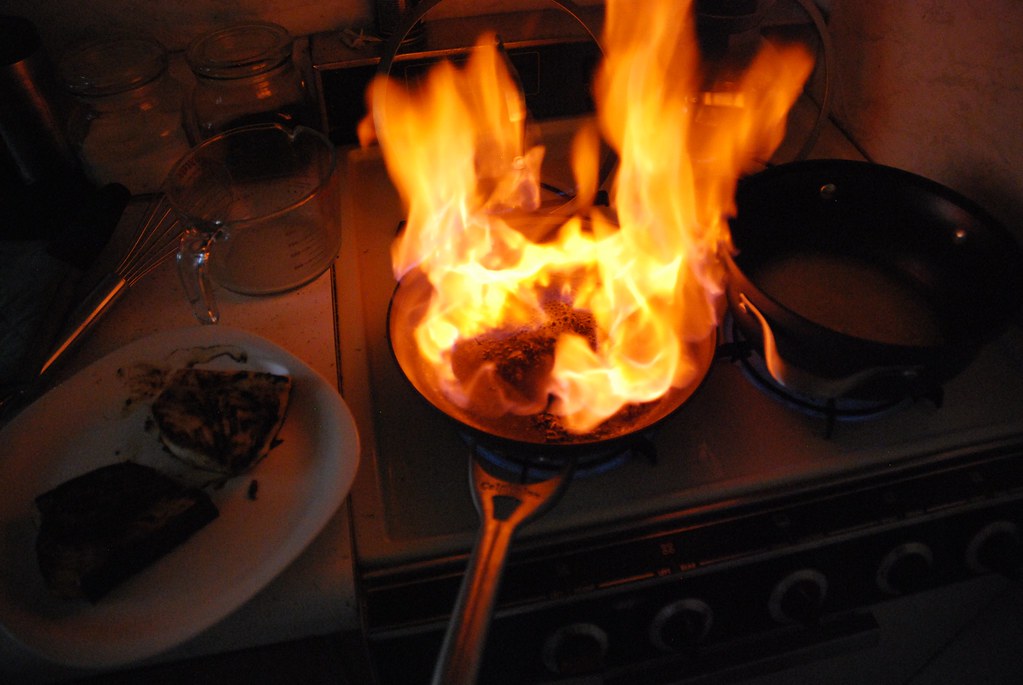

Here is the flambé in action (step IX).

Once the fire dies out pour the dark liquid in the syrup. (it is tasty regardless the dark color). Boil it until it thickens a little more. This will be a very complex flavor. Hints of dark caramel, fish, sweet and tart, a little spicy, salty… it is party.

Once the consistency is right (like a light syrup) pour part of it on a plate to coat the bottom.
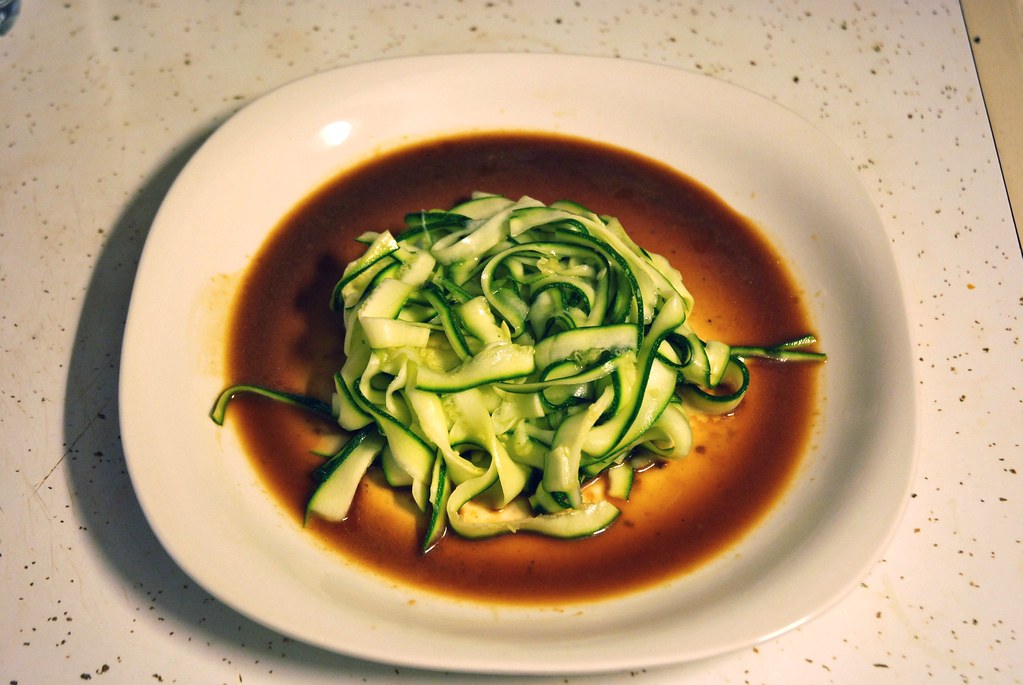
Add on top the zucchini.
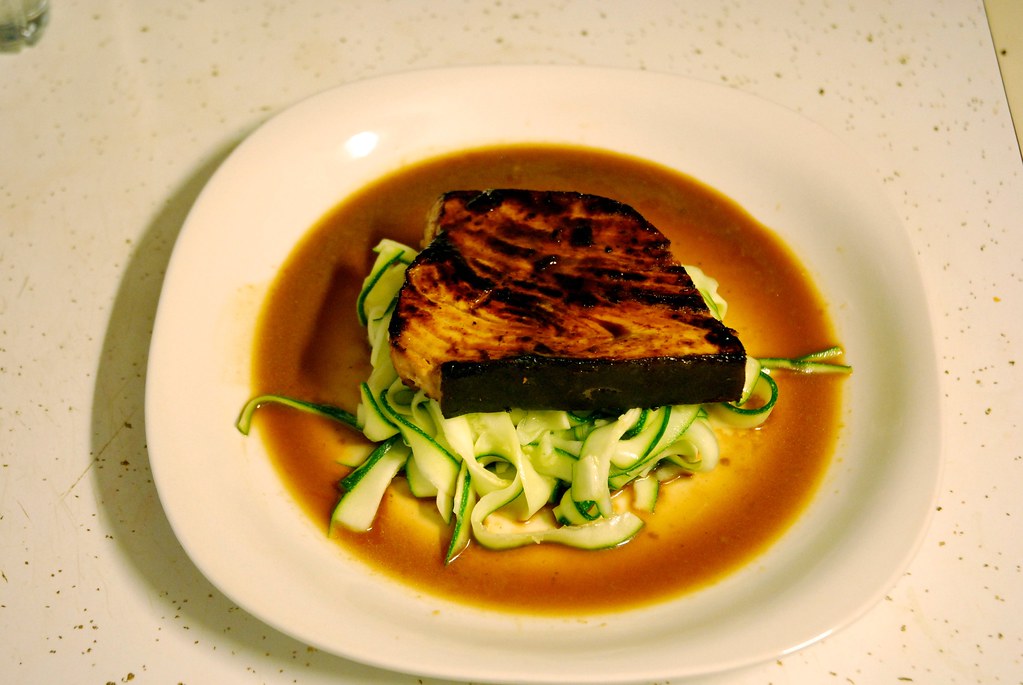
Sit on top of it the swordfish.

Top it off with a couple of spoonfuls of tasty salsa. Some of it will just drip on the sides. It is a nice effect.
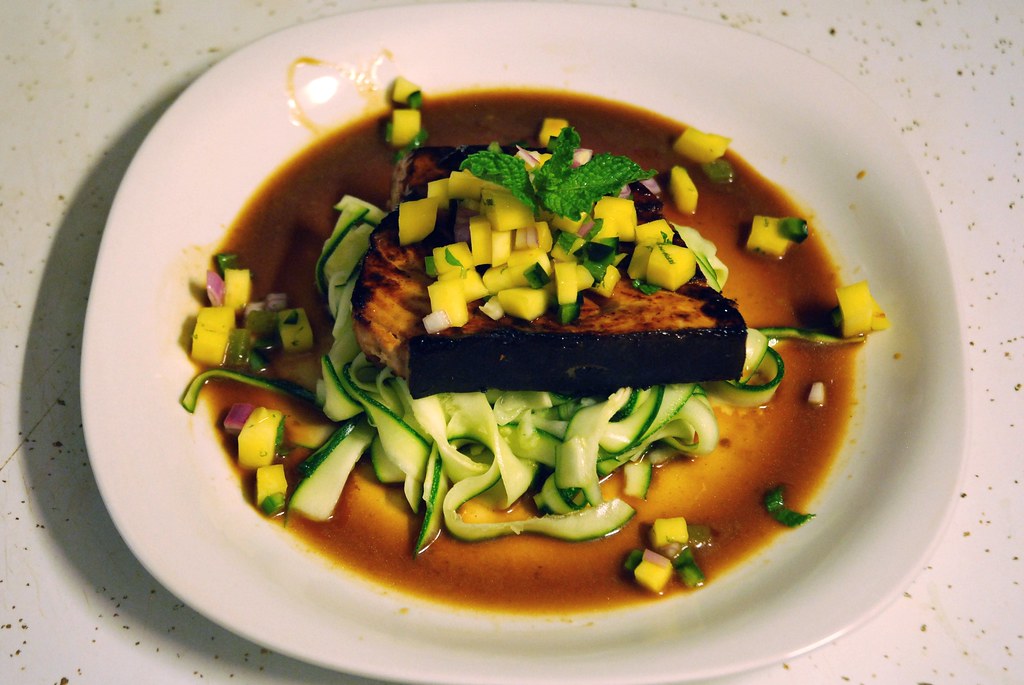
And decorate with a mint leave.
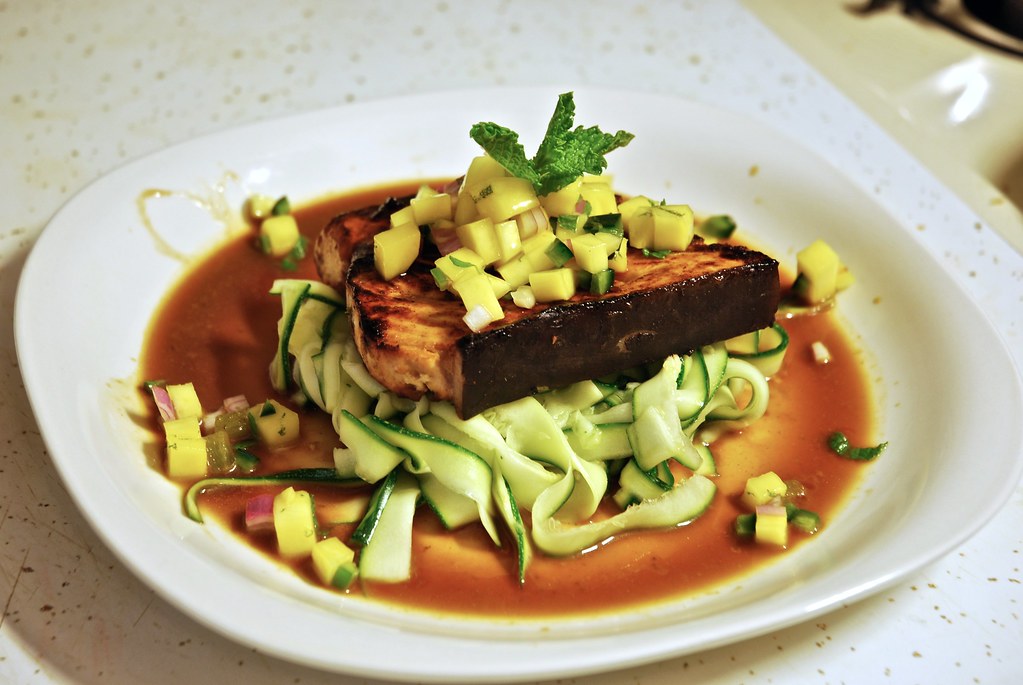
A great dish and (kinda) easy to make. Of course the same ingredients instead on a plate can go in taco shell for an amazing fish taco. The zucchini instead of the lettuce, salsa, fish. Summer welcome!
Printable Recipe Card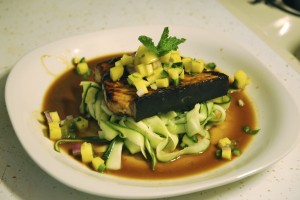
Ingredients
-
1 lb Swordfish steaks (2 average pieces)
-
1 large zucchini
-
1 mango
-
1 Jalapeño
-
1 red onion
-
1/2 poblano peper
-
2 limes
-
Mint (or cilandro)
-
Cayenne pepper
-
Olive oil
-
Salt and pepper
-
1 oz Tequilla (optional)
Directions
- Peel and mince the onion the poblano and the mango.
- Cut the jalopeño in half and remove the seeds.
- One half roast it over open flame.
- Chop both halts into fine dice.
- Mix everything and season with agave, lime and salt.
- Take half of the pico de gallo and with a muddler or a blender make it to a paste.
- Add to the paste olive oil. This will be the marinate of the swordfish. If it is too thick add the add water.
- Add the swordfish and marinate it for up to two hours.
- Cut the zucchini in half, and w remove the seeds.
- With a peeler start shaving off thin strips from the zucchini resembling lasagna.
- Salt the zucchini strips and let them get softer and tender.
- Heat up the pan and add some oil.
- when the pan is hot add the swordfish. Cook both sides for 2-3 mins. Until they get a nice color.
- If you want use the tequila to flambé.
- Serve the steak on top of the zucchini and top it off with the reserved mango pico de gallo.
Tips
- Flambè is great way to utilize the bits and pieces left on the pan. Be very careful and follow the ten rules:
- 1. Clear your airspace. No towels, hands, faces or eyebrows over the pan.
- 2. Make sure you have lid, larger than the pot, to cover the pan if things go wrong and a pair of tongs to handle it with.
- 3. Make sure you know where your fire extinguisher is.
- 4. Turn the heat off.
- 5. Pour a shot of the tequila (or any other liquid).
- 6. Wait a few seconds for the first sizzle to finish.
- 7. Light up the flambé with a long match or lighter (preferred).
- 8. Turn the heat back on, to medium.
- 9. Take your pictures for Facebook etc.
- 10. Wait till the fire dies out.




